
The Merchants' National Bank (1914) building is a historic commercial building located at 833 Fourth Avenue in Grinnell, Iowa. It is one of a series of small banks designed by Louis Sullivan in the Midwest between 1909 and 1919. All of the banks are built of brick and for this structure he employed various shades of brick, ranging in color from blue-black to golden brown, giving it an overall reddish brown appearance. It was declared a National Historic Landmark in 1976 for its architecture. In 1991 it was listed as a contributing property in the Grinnell Historic Commercial District.

The People's Federal Savings and Loan Association is a historic bank building at 101 East Court Street in Sidney. It is an early-modern building in western Ohio, designed by Chicago architect Louis Sullivan, the mentor of Frank Lloyd Wright. It was designed and built in 1917 for use by Peoples Federal Savings and Loan Association, which still operates out of it. It is one of a handful of banks designed by Sullivan between 1908 and 1919 for small communities in the central United States. The building is a National Historic Landmark.

The Dubuque County Jail is a historic building at 36 East 8th Street in Dubuque, Iowa, United States. Completed in 1858, the jail is an example of the uncommon Egyptian Revival style. It is architecturally a highly original work of John F. Rague, who also designed the 1837 Old Capitol of Illinois and the 1840 Territorial Capitol of Iowa. The building was designated a National Historic Landmark for its architecture in 1987. It served as a jail for more than a century, became a museum in 1975, and was converted into county offices in 2016.
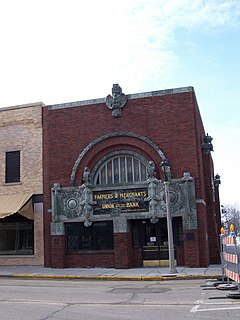
The Farmers and Merchants Union Bank is a historic commercial building at 159 West James Street in Columbus, Wisconsin, Built in 1919, it is the last of eight "jewel box" bank buildings designed by Louis Sullivan, and the next to last to be constructed. It was declared a National Historic Landmark in 1976 for its architecture.

West Vernor–Junction Historic District is a commercial historic district located along West Vernor Highway between Lansing and Cavalry in Detroit, Michigan. The district includes 160 acres (0.65 km2) and 44 buildings. The district was listed on the National Register of Historic Places in 2002.

Davenport Bank and Trust Company was for much of the 20th century the leading bank of the Quad Cities metropolitan area and the surrounding region of eastern Iowa and western Illinois. It was at one time Iowa's largest commercial bank, and the headquarters building has dominated the city's skyline since it was constructed in 1927 at the corner of Third and Main Streets in downtown Davenport, Iowa. It was acquired by Norwest Bank of Minneapolis in 1993 and now operates as part of Wells Fargo following a 1998 merger of the two financial institutions. The historic building was listed on the National Register of Historic Places in 1983 under the name of its predecessor financial institution American Commercial and Savings Bank. In 2016 the National Register approved a boundary increase with the Davenport Bank and Trust name. It was included as a contributing property in the Davenport Downtown Commercial Historic District in 2020. It remains the tallest building in the Quad Cities, and is today known as Davenport Bank Apartments as it has been redeveloped into a mixed-use facility housing commercial, office and residential space.
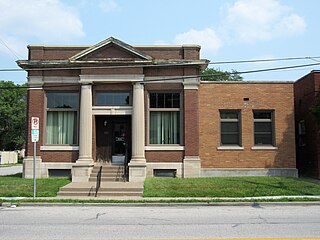
Northwest Davenport Savings Bank is a historic building located in a commercial district in the old northwest section of Davenport, Iowa, United States. It has been listed on the National Register of Historic Places since 1984.
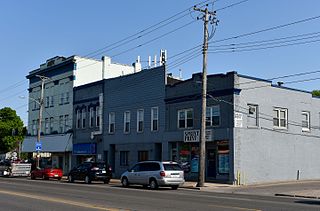
The College Corner Commercial Historic Business District, also known as the Highland Park Historic Business District at Euclid and Second, is located in the north-central section of Des Moines, Iowa, United States. It is located in the Highland Park neighborhood that also includes the Highland Park Historic Business District at Euclid and Sixth Avenues. The College Corner historic district has been listed on the National Register of Historic Places since 1998.

Farmers and Merchants Savings Bank, also known as Union Savings Bank and First Trust and Savings Bank, is an historic building located in Grand Mound, Iowa, United States. It was listed on the National Register of Historic Places in 2001.
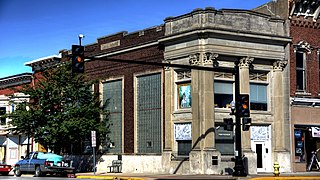
Tipton State Bank is a historic building located in the central business district of Tipton, Iowa, United States. It was listed on the National Register of Historic Places in 2000. A bank on this location in Tipton goes back to 1877. Over the years it was known as Cedar County Bank, First National Bank of Tipton, and City National Bank. The directors of City National Bank voted on March 28, 1923 to build a new bank building. They hired the Clinton, Iowa architectural firm J.C. Woods & Co. to design the Neoclassical style structure. Construction was completed in 1924. The east facade of the two-story building features three columns with capitals in the Corinthian order. Around the corner on the south elevation are two full size pilasters. The windows of that elevation were replaced with glass blocks in 1953. After the National Banking Holiday the bank resumed operations as the Tipton State Bank. It continued to occupy this building until they built a new facility across Cedar Street in 1967.

The First National Bank, now known as U.S. Bank, is a historic building located in Maquoketa, Iowa, United States. The Lytle Company of Sioux City, Iowa designed this building for First National Bank. Between 1913 and 1923 they were responsible for designing at least twenty-five bank buildings in Iowa, mostly in smaller communities. The Neoclassical style building is faced with terra cotta produced by the American Terra Cotta Company of Chicago. Completed in 1920, the two-story, double-wide structure features four columns in the Ionic order. Its various design elements include Greek key, Egg-and-dart, foliated rinceau, rosettes, anthemion, and volutes. First National Bank failed in the Great Depression, and the building was taken over by Jackson State Bank. It now houses a branch of US Bank. The building was listed on the National Register of Historic Places in 1991.

The Guttenberg State Bank, also known as the People's Bank, is a historic building located in Guttenberg, Iowa, United States. The bank was incorporated in May 1900 with John P. Eckert was its president. The bank was also referred to as "Eckert Bank". They built this building two years later. It is a two-story brick structure that features a round tower with a conical roof on the corner. The second floor windows are topped with inlaid brick arches that combines with a brick stringcourse. Above is a brick cornice.

Siebels' Department Store-Boyer Valley Bank, also known as I.0.0.F. Hall, Nicely Building, Whitmore's, and the Rena Barry Building, is a historic building located in Woodbine, Iowa, United States. Siebels' was one of the largest, longest-lasting and most well-known stores in Woodbine. Adolph Siebels moved here from Minden, Iowa in 1904 and bought a grocery store. He expanded the store's offerings to include clothing, housewares and other items. Siebels expanded the store in 1907 and again in 1908. He sold shares in the store to some of his employees in the 1920s, and the store remained in business under three owners until 1954.
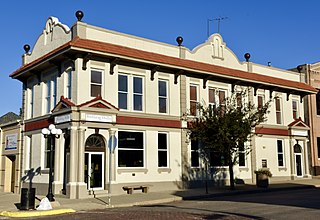
German Bank Building of Walnut, Iowa, also known as the Walnut State Bank Building, is a historic building located in Walnut, Iowa, United States. A two-story, brick building was completed on this corner in 1884. It housed a blacksmith shop and a land and loan business by 1887. The German Savings bank was organized in 1893, and used this building for a short time before it folded the following year. It was reorganized and re-opened in 1898. They renovated the building to its present exterior in the Mission Revival style in 1916, and the interior in 1920. The interior renovation was done by the St. Louis Bank Equipment Company. The Walnut Telephone Company began as a tenant on the second floor in 1919. While German immigrants remained in control, the bank's name was changed to American State Bank in 1920 because of anti-German sentiment following World War I. It was reorganized in 1923 as the Walnut State Bank. It was listed on the National Register of Historic Places in 1991.
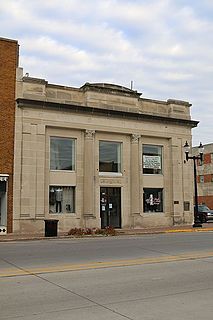
First National Bank is a historic building located in Mount Pleasant, Iowa, United States. The bank was first located on this corner in the 1860s. Its first building was a small, brick Italianate structure. This building replaced it in 1923. It is a two-story stone structure designed by Chicago architect Paul V. Hyland in the Neoclassical style. It is unique in Mount Pleasant in that it is the only stone building facing the square, and it reflects more of a public building instead of a commercial building. It is similar in style to the Henry County Courthouse, which is diagonally across the square. The exterior of the primary and secondary facades is composed of ashlar limestone and features paired pilasters on the corners of the primary facade, and a single column in the Corinthian order that flank the main entrance. It is capped with a simple classical cornice and parapet roof. The alley side of the building is composed of red brick. The building was listed on the National Register of Historic Places in 1991.

Henry County Savings Bank is a historic building located in Mount Pleasant, Iowa, United States. Because this two story, brick Italianate structure was built specifically as a bank, it features a chamfered corner, which was commonly used to designate a bank in the last quarter of the 19th century. Other features typical of an Italianate commercial building include segmental arched windows, a corbeled brick frieze, and a bracketed metal cornice. The building was listed on the National Register of Historic Places in 1991.

National State Bank is a historic building located in Mount Pleasant, Iowa, United States. Because this two story, brick Italianate structure was built specifically as a bank, it features a chamfered corner, which was commonly used to designate a bank in the last quarter of the 19th century. However, it combines other features typical of an Italianate commercial building in an unusual way. The secondary facade has segmental arched windows that are regularly spaced, while the primary facade has the windows in a sophisticated arrangement that one would expect of an architect-designed building. The metal cornice has widely spaced brackets on the primary facade and more typically spaced on the secondary facade. It also lacks an identification pediment on the corner, which is typical of the style. The building was listed on the National Register of Historic Places in 1991.
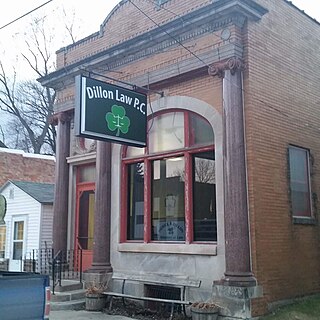
Farmers' State Bank is a historic building located in Volga, Iowa, United States. Its significance is derived from its Beaux-Arts architecture and the bank's role in the town's early 20th-century agriculture-based economy and railroad development along a branch of the Chicago, Milwaukee & St. Paul Railroad. Completed in 1912, the Beaux Arts elements on the buildings main façade includes a large elliptical-arch window, Ionic granite columns, classical entablature, and circle window above the door framed by garlands. Farmers' State Bank was Volga's second financial institution. It survived the downturn in the farm economy in the 1920s before it merged with the other bank in town in 1931 to form Iowa State Savings Bank. That bank used this building until the following year when it failed. The city of Volga acquired the building in 1935 and used it for its public library and city hall. It was used for a bank again from 1947 to 2015 when it housed Volga State Bank and the Volga branch of Central State Bank of Elkader. The building then housed a law office. It was listed on the National Register of Historic Places in 2018.
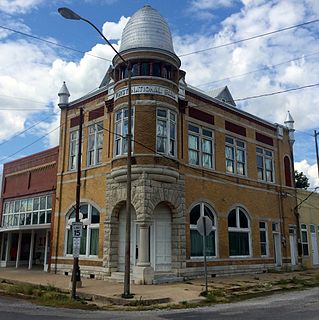
The First National Bank Building in Stratford, Oklahoma, at 100 West Main, was built in 1907. It was listed on the National Register of Historic Places in 2001.





















